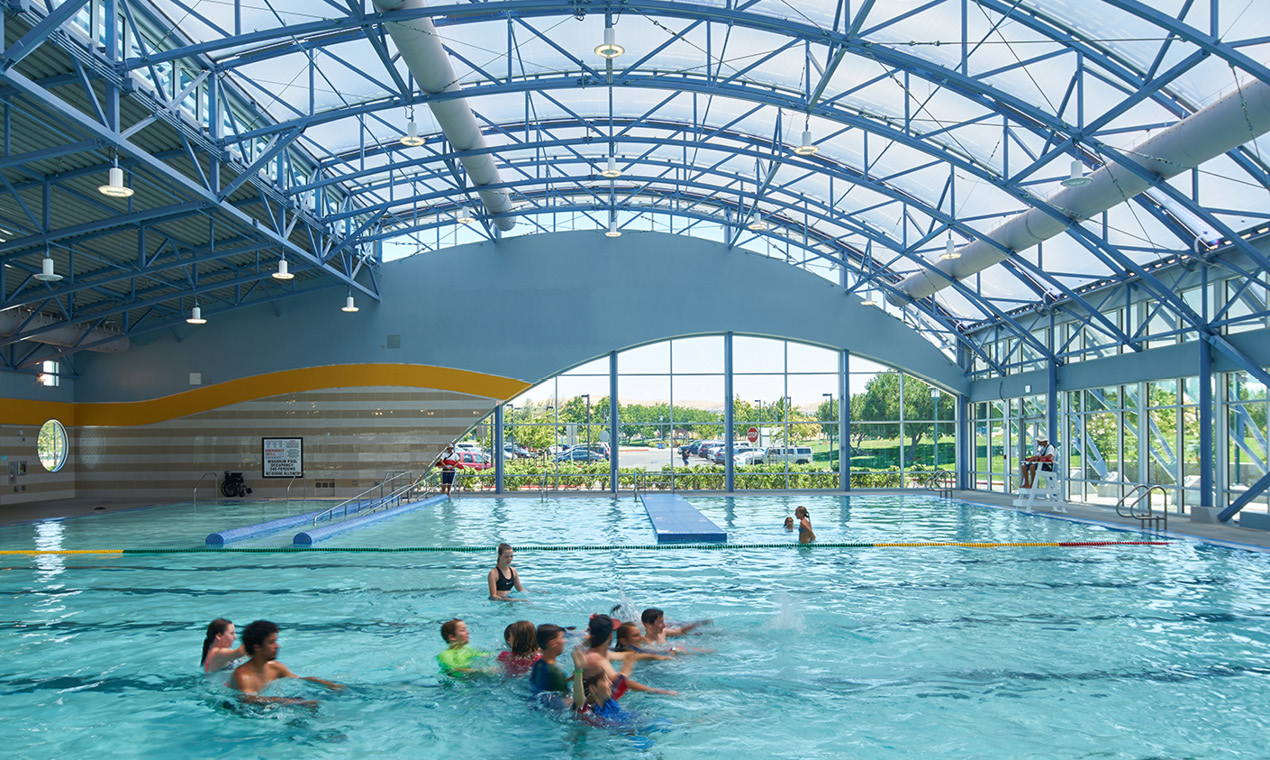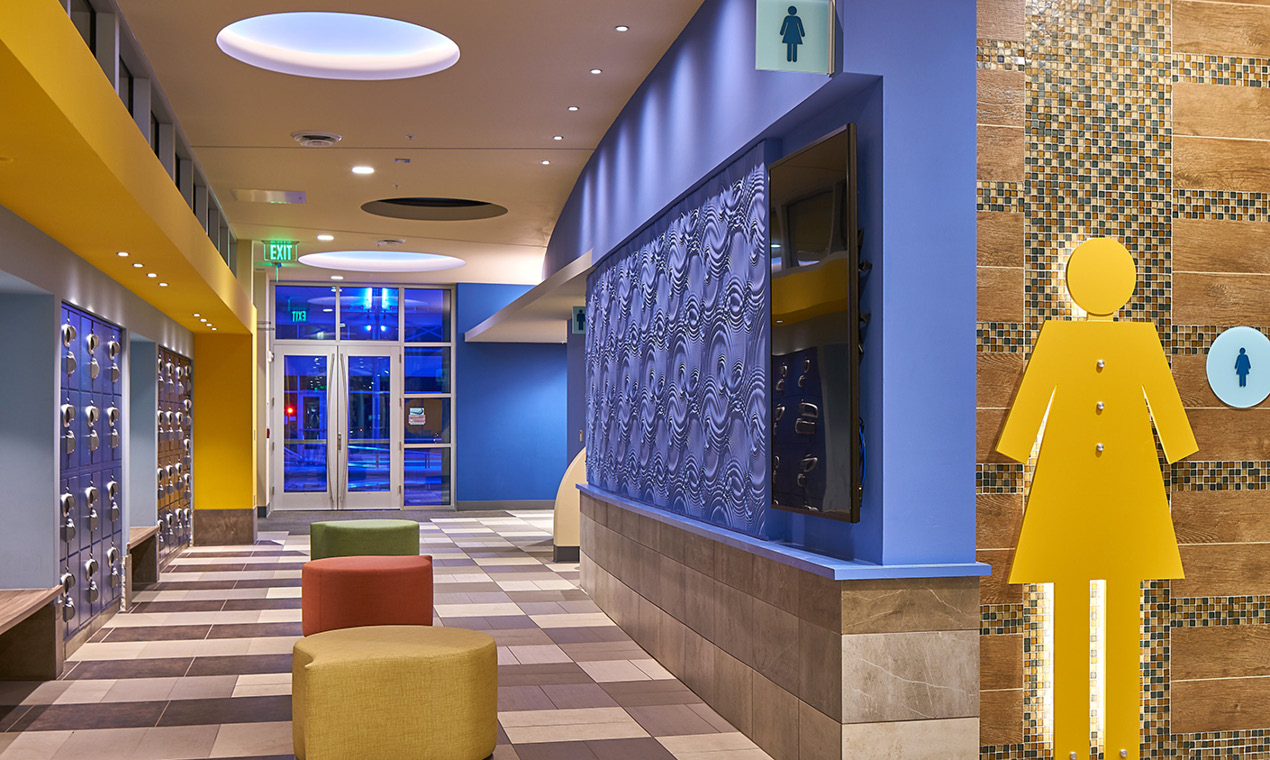The programmatic needs of aquatic facilities generally fall into four categories: learning, competition, recreation, and fitness. Although each of these categories has different end goals, all can benefit from maximizing operational efficiencies and revenue opportunities—both of which can be addressed through smart and sustainable design.
Reaching beyond basic programmatic needs, owners, operators and designers all seek aesthetically appealing, functional design and material selections that aim to meet safety standards, maximize the overall investment and reduce costs to ensure the longevity of the facility. One aspect when looking at efficient operations for the long term is the incorporation of sustainable elements that reduce overall building energy use. The integration of sustainable elements comes in many shapes and forms—some visible and some hidden—but they are always served best when integrated into the overall design and vision.
SMART Design—design that is sustainable, maintainable, adaptable, responsive and thoughtful—is imperative in creating and renovating community facilities. The following design features can provide aesthetic, functional and energy-saving benefits.
OVERHANGS & INTEGRATED SHADES
When properly implemented, roof overhangs, awnings and integrated building shades allow for large expanses of glass to create views from within the facility and help control solar heat gain from direct sun exposure. Awnings should be strategically placed to block glare in winter months and minimize solar gain during summer months. Awnings can also serve as dynamic design elements to cast ever-changing shadows or messages.
In situations where use of a deep overhang or integrated shades is not desired, tinted electrochromic glass may be an option. An electronically tint-able glass in which building occupants or automation systems can directly control the opacity of the glass, electrochromic glass allows for maximum access to daylight and eliminates the need and cost of a secondary shading system. "Smart glass" can be programmed for individual zones in order to respond to different solar orientations and programming, as needed.
SKYLIGHTS & ETFE ROOFS
One of the easiest ways to reduce operating costs is to decrease electrical consumption and maximize daylight. Integrating solar tubes and skylights is an effective passive method to reduce electrical load. Skylights maximize natural daylight into spaces that cannot accommodate windows. In more constrained spaces, solar tubes offer a similar benefit with a small footprint. With premanufactured flexible systems, solar tubes are a cost-efficient solution for new construction and renovation projects.
On a larger scale, ETFE (ethylene tetrafluoroethylene) systems are a cutting-edge solution for maximizing daylight. ETFE is a plastic designed to have high corrosion resistance and strength, with the ability to resist a high temperature range, that can be used for both roof and wall panel systems. Providing a futuristic design while maximizing daylight, ETFE transforms enclosed areas into bright, dynamic spaces that allow occupants to feel as though they are outdoors while enjoying protection from the elements.
As a roof system, ETFE provides several benefits:
>> Lightweight & highly transparent: Only 1% of the weight of glass, yet capable of transmitting 95% of outdoor light. As an example, the ETFE roof at The WAVE in Dublin, Calif. sits over the natatorium and provides the room with light without the need for columns intruding into the openness of the space. The reduction in weight reduced the need for structural framework and granted faster installation compared to similar glazed systems. The high translucency of the material decreases the need for artificial lighting levels while controlling unwanted solar gain. The strategic placement of color-changing LED lights integrated with the ETFE pillow structure creates a true iconic glowing beacon for the park that can flex to celebrate occasions throughout the year.
>> Noise reduction: With 70% acoustic absorption/transmittance, sound generated by building occupants passes through the ETFE foil and is not reflected back into the space below, unlike less acoustically transparent materials such as glass. As most indoor pool enclosures are concrete, metal and glass, it's no surprise that one of the biggest complaints when it comes to natatoriums is the excessive noise level. An ETFE roof dramatically reduces ambient noise through the reduction of sound reverberation.
>> Durability: As a material that is designed to be corrosion- and chemical-resistant, ETFE does not degrade or color with UV exposure, and studies suggest a lifetime of 50-plus years.
>> Self-cleaning: With low coefficient of friction, ETFE is a cost-effective maintenance feature, preventing dust and debris from adhering to the roof.
>> Recyclable: At the end of their usable life, ETFE panels can be recycled and made into small components needed for the manufacture of new systems.

ADDITIONAL SUSTAINABLE DESIGN COMPONENTS
There are several energy and water-conserving features that owners can consider to ensure efficient facility operations. These systems have become more sophisticated over time, allowing for automated elimination of unnecessary after-hour lighting or equipment running, which ultimately saves on energy use and increases the overall life expectancy of lighting fixtures and equipment:
>> Solar energy to heat the pool and indoor pool enclosures.
>> High-efficiency LED lighting, including accent lighting to provide general illumination and accent (color) punches for enhanced aesthetics.
>> Variable speed motors.
>> Stormwater filtering systems.
>> Drought-tolerant landscaping with a state-of-the-art irrigation system.
>> Low-flow fixtures to minimize potable water use.
>> Vehicle charging stations.

WATER CONSERVATION FEATURES
Stewardship and conservation of fresh water is a key element of aquatic centers. The following features provide a direct impact on aquatic center operating costs:
>> Pool covers save energy by helping to maintain heat and reduce evaporation.
>> Reduction in pool temperatures combats evaporation.
>> Regular equipment maintenance helps keep filters and other equipment running effectively, prevents leaks in the pool shell, and reduces overall water consumption.
>> Water-free urinals can save up to 40,000 gallons of water a year.
This article first appeared in Recreation Management.







